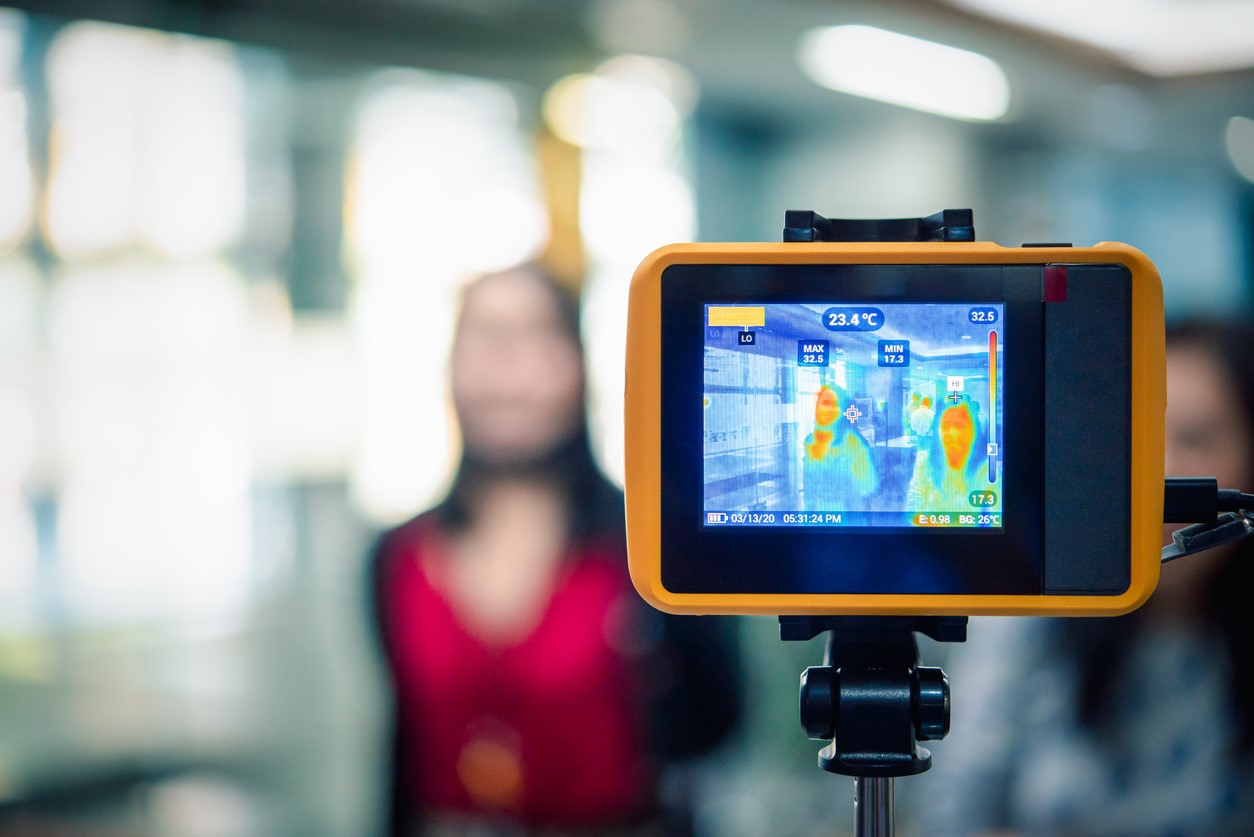Thermal cameras are just one of the many new systems companies are putting in place to better monitor employees and visitors who may show symptoms of the coronavirus
As the COVID-19 pandemic continues to spread, forcing businesses to close and putting people out of work, many employers are trying to find ways to restart business without putting workers and customers at risk.
One of the recommendations made by the Centers for Disease Control and Prevention (CDC) is to pre-screen employees by taking their temperature and evaluating any symptoms before they begin work. To speed up these processes, many businesses are scrambling to gain access to thermal imaging devices, such as cameras that can detect high body temperatures. Companies can then flag employees or visitors who register higher temperatures for further screening or even deny them access to the building.
Here’s a look at how these thermographic devices work and innovations that may be able to help update your practices in this new and ever-changing pandemic environment.
How does thermal imaging work?
Thermographic devices can detect heat in the form of infrared light that humans can’t see with the naked eye. These devices are widely used across industries, including surveillance, to detect humans and animals in indoor and outdoor spaces. They’re also used to detect different building structural patterns or obstructions.
In addition to detecting the heat a human emits, thermographic technology can detect different levels of temperature. Thermal imaging devices can track temperature patterns instantly, and since a fever is one of the most common symptoms of the coronavirus, that makes them useful for spotting people who may have the virus.
Thermal imaging devices can thus be an important health and safety component as the world starts to navigate the reopening of businesses.
Thermal imaging cameras in use
Gone are the days when we had to depend on under-the-tongue thermometers to evaluate and monitor body temperature. The integration of thermal cameras is one new tactic that could provide a simple and safer, non-contact way for companies to screen employees and visitors for temperature in a walking pattern.
These enhanced cameras can detect elevated body temperatures and have already been or plan to be used for multiple purposes in buildings with a lot of foot traffic, such as airports, shopping malls, distribution centers, manufacturing facilities, grocery stores, schools, and many more.
When thermal cameras detect higher temperature among those entering a workspace, these individuals can be selected for additional testing. While the cameras, of course, cannot detect or diagnose coronavirus, they are helpful in a comprehensive detection system to alert management to individuals who may have a fever. Companies should keep in mind that thermal screening is not intended to be the basis to diagnose or exclude SARS-CoV-2 infection or to inform infection status (any medical diagnosis must be made by a doctor). However, thermal technology can certainly be an effective precaution when limiting the number of people entering a property.
Portable thermal imaging tools
Aside from cameras, there are other thermal imaging devices and equipment that serve the same purpose and may be better for certain types of organizations. Some companies produce thermal imaging sensors, including portable thermal imagers for detecting temperature changes, which is a quick and simple solution that many companies can integrate. Unisee’s device is handheld and can function on battery power for about four hours.
These devices may be easier to manage than other thermal cameras because of their portability and convenience. They can also be mounted on a tripod and measure best at around 3.3 feet (1 meter) from the target.
Rapid temperature screening systems
Another type of thermal imaging system is a bi-spectral infrared body temperature fast screening system. This device was developed to screen specifically for body temperature using thermal radiation technology. It’s paired with software that immediately displays an individual’s temperature information and can be used in high-traffic areas.
While thermal cameras and detection systems aren’t holistic solutions for preventing the spread of coronavirus in workers, they’re valuable to businesses as part of a multi-step screening process that can protect your employees and customers. Some are more accurate than others in detecting high body temperatures, and businesses should implement further testing practices to supplement thermographic equipment.
As COVID-19 continues to change the way organizations operate for the foreseeable future, thermographic technologies are becoming a popular integration for companies of all sizes that continue to implement practices to protect workers and customers.
For additional regulatory information please refer to the Public Health Emergency policy for Telethermographic Systems During the Coronavirus Disease 2019 (COVID-19), published by the FDA.
Unisol International provides a range of products for the modern business, including thermal cameras and temperature screening systems. The team also delivers turn-key deployments of IP networking solutions, other surveillance technologies, and video management software.
Contact Unisol International today to learn about how thermal imaging solutions can specifically help your business navigate these unprecedented times. In addition, thermographic technology is controlled for export. Unisol can also assist international customers in following applicable export rules and regulations when thermal imaging technology is intended to be deployed overseas.
